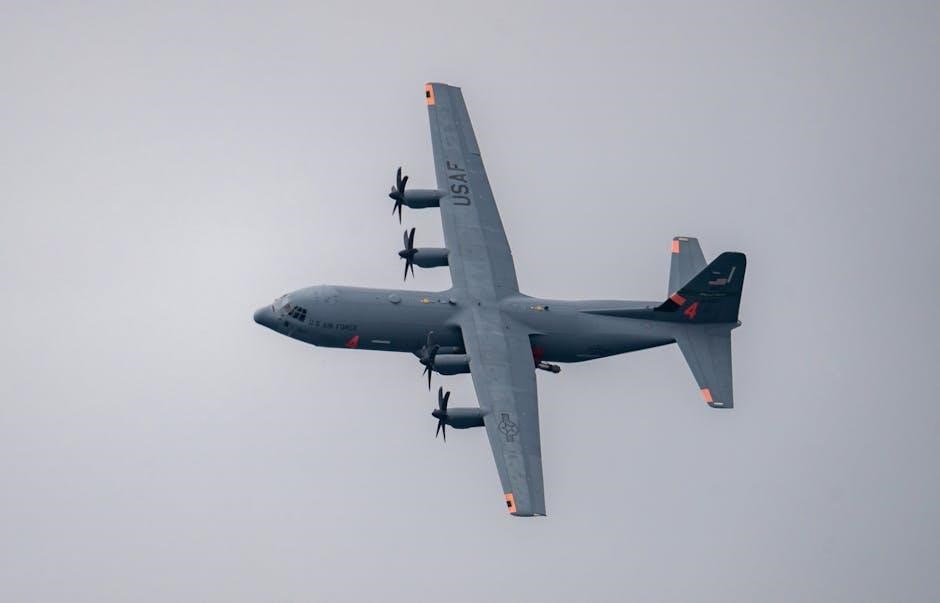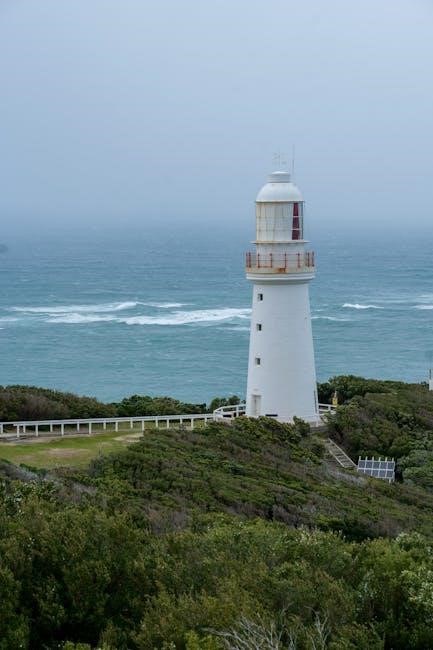Welcome to the Mercruiser Alpha One Propeller Guide, your comprehensive resource for understanding and optimizing your boat’s performance․ This guide covers essential topics such as propeller selection, installation, and maintenance, ensuring you maximize efficiency and speed․ Whether you’re a seasoned boater or new to the Mercruiser system, this guide provides the insights you need to make informed decisions for your vessel․
1․1 Overview of the Mercruiser Alpha One Drive System
The Mercruiser Alpha One Drive System is a sterndrive propulsion system designed for marine applications, offering reliability and performance․ It pairs with engines like the 5․7L Alpha 1 Gen 1 and uses propellers available in aluminum or stainless steel․ Compatible with various boat sizes, the system supports activities from cruising to water sports․ Proper propeller selection is crucial for optimal performance, with models like Quicksilver and Solas being popular choices․ The Alpha One is part of Mercruiser’s sterndrive lineup, which also includes Bravo One, both designed for engines under 400 HP․ The system’s efficiency and durability make it a preferred choice for many boaters․
1․2 Importance of Choosing the Right Propeller
Selecting the correct propeller for your Mercruiser Alpha One is vital for maximizing performance, fuel efficiency, and overall boating experience․ A properly matched propeller ensures optimal RPM range, reducing engine strain and improving speed․ Incorrect pitch or blade count can lead to poor performance, increased fuel consumption, and potential engine damage․ Factors such as boat size, engine power, and usage must be considered․ High-quality options like Solas and Quicksilver propellers are designed to meet these needs, offering durability and enhanced performance for both aluminum and stainless steel configurations, ensuring your vessel operates at its best under various conditions․

Understanding Mercruiser Alpha One Propeller Basics
This section explores the fundamental aspects of Mercruiser Alpha One propellers, including types, materials, and key terms like pitch, diameter, and blade count, essential for optimal performance․

2․1 Types of Propellers Compatible with Alpha One
The Mercruiser Alpha One system supports various propeller types, including aluminum, stainless steel, and plastic․ Aluminum propellers are durable and cost-effective, ideal for smaller boats․ Stainless steel propellers offer superior strength and performance, making them suitable for larger boats or heavy use․ Plastic propellers are lightweight and often used for training or entry-level applications․ Each type is designed to optimize performance based on boat size, engine power, and usage conditions․ Choosing the right propeller type ensures better fuel efficiency, speed, and overall boating experience․ Proper selection is crucial for maximizing the Alpha One drive system’s potential․
2․2 Materials Used in Mercruiser Alpha One Propellers
Mercruiser Alpha One propellers are crafted from high-quality materials to ensure durability and performance․ Aluminum propellers are popular for their affordability and corrosion resistance, making them ideal for freshwater use․ Stainless steel propellers, while more expensive, offer superior strength, durability, and resistance to corrosion, suitable for saltwater and heavy-duty applications․ Both materials are precision-engineered to optimize boat speed, fuel efficiency, and overall performance․ The choice of material depends on the boat’s operating conditions, ensuring the Alpha One system operates efficiently and reliably in various environments․
2․3 Key Terms: Pitch, Diameter, and Blade Count
Understanding propeller terminology is crucial for optimal performance․ Pitch refers to the angle of the propeller blades, measuring how far the propeller moves forward with one rotation․ A higher pitch increases speed but may reduce RPM, while a lower pitch improves acceleration․ Diameter is the distance across the propeller from tip to tip, affecting how much water it moves․ Larger diameters provide more thrust but can reduce top speed․ Blade count impacts efficiency; more blades enhance smooth operation but may slightly reduce speed․ Balancing these factors ensures the best performance for your Mercruiser Alpha One․
History and Evolution of the Mercruiser Alpha One
Introduced in the 1960s, the Mercruiser Alpha One revolutionized marine propulsion with its sterndrive design, combining efficiency, reliability, and ease of use, shaping modern boating performance․

3․1 Development of the Alpha One Drive System
The Alpha One drive system was first introduced in the 1960s, marking a significant leap in marine propulsion technology․ Designed for reliability and performance, it featured a compact, user-friendly sterndrive design that simplified boat handling․ The system incorporated corrosion-resistant materials and a robust gearcase, ensuring durability in harsh marine environments․ Its development focused on improving efficiency, reducing maintenance, and enhancing overall boating experiences․ The Alpha One quickly became a standard in the industry, paving the way for future innovations in sterndrive technology and solidifying Mercruiser’s reputation as a leader in marine propulsion․
3․2 Advancements in Propeller Design for Alpha One
Over the years, propeller design for the Alpha One system has seen significant advancements, focusing on efficiency, durability, and performance․ The introduction of stainless steel and aluminum propellers offered improved corrosion resistance and strength․ Design innovations, such as cupped blades and modified tip designs, enhanced thrust and reduced cavitation․ Additionally, the development of hub kits and interchangeable hub systems provided easier maintenance and customization․ These advancements have allowed boaters to optimize their Alpha One system for specific applications, ensuring better fuel efficiency, higher speeds, and smoother operation across various water conditions and boat types․

Selecting the Right Propeller for Your Mercruiser Alpha One
Choosing the right propeller involves considering boat size, engine power, and usage․ Proper selection ensures optimal performance, fuel efficiency, and smooth operation for your Alpha One system․
4․1 Factors to Consider: Boat Size, Engine Power, and Usage
When selecting a propeller for your Mercruiser Alpha One, consider your boat’s size, engine power, and usage․ Larger boats require more torque, while smaller boats need less․ Engine power, measured in horsepower and torque, dictates the propeller’s load capacity․ Usage, such as cruising, towing, or racing, influences pitch and blade count․ A propeller mismatched to these factors can lead to poor performance, reduced efficiency, or even engine strain․ Ensure your selection aligns with these criteria for optimal speed, fuel efficiency, and overall system balance․
4․2 How to Read Propeller Specifications
Understanding propeller specifications is crucial for making the right choice․ Propellers are typically labeled with numbers like 14×19, where 14 is the diameter (in inches) and 19 is the pitch (in inches)․ Diameter affects how much water the propeller moves, while pitch influences speed and RPM․ Blade count (3, 4, or 5) impacts efficiency and smoothness․ Materials (aluminum, stainless steel, or bronze) also vary․ Always match these specs to your boat’s requirements, as outlined in your engine’s manual or manufacturer guidelines․ Proper alignment ensures optimal performance and longevity․
4․3 Step-by-Step Guide to Choosing the Optimal Propeller
Selecting the right propeller involves a systematic approach․ First, determine your boat’s specific needs, including its size, weight, and intended use․ Next, consult your engine’s horsepower and RPM range․ Use a propeller selection guide or calculator to narrow down options․ Test different props on the water to assess performance․ Pay attention to RPM, acceleration, and top speed․ Fine-tune by adjusting pitch or blade count if needed․ Always prioritize efficiency, smooth operation, and durability to ensure your Mercruiser Alpha One performs at its best․

Installation and Maintenance of the Mercruiser Alpha One Propeller
Proper installation ensures alignment and securement․ Regular maintenance involves inspections, cleaning, and timely repairs to prevent damage from debris and ensure optimal performance․
5․1 Best Practices for Propeller Installation
Ensure the propeller is properly aligned with the drive system to avoid vibration and damage․ Use a hub kit or spacer if necessary for accurate fitting․ Tighten the propeller nuts in a star pattern to maintain even pressure and prevent warping․ Apply the recommended torque specifications to secure the propeller safely; Always grease the propeller shaft before installation to reduce friction and corrosion․ Finally, inspect the propeller for any damage or debris before reinstalling․ Proper installation ensures optimal performance, reduces wear, and prevents costly repairs down the line․
5․2 Routine Maintenance Tips for Longevity
Regularly inspect the propeller for dings, nicks, or corrosion, as these can affect performance and longevity․ Clean the propeller and hub thoroughly after each use to remove debris and marine growth․ Apply a marine-grade propeller coating or wax to protect against corrosion․ Check the propeller shaft for alignment issues and ensure proper lubrication․ Store the propeller in a dry, protected area during off-seasons to prevent rust․ Inspect and replace worn-out propeller bushings or seals annually․ Regular maintenance ensures your Mercruiser Alpha One propeller remains in optimal condition, enhancing performance and extending its lifespan significantly․
5․3 Tools and Equipment Needed for Propeller Maintenance
To maintain your Mercruiser Alpha One propeller, essential tools include a propeller wrench for removal and installation, a torque wrench for secure tightening, and a blade straightening tool to correct minor bends․ A propeller puller is useful for stuck propellers, while a dial indicator helps check shaft alignment․ A propeller balancer ensures even weight distribution․ Protective gloves and safety glasses are crucial for safety․ Additionally, keep marine grease for lubrication, a propeller zinc or anode for corrosion protection, and a storage rack for off-season protection․ A service manual is also handy for guidance․

Performance Optimization with the Right Propeller
Optimizing performance involves selecting the ideal propeller for your Mercruiser Alpha One, ensuring maximum speed, efficiency, and engine longevity while minimizing wear on the drive system․
6․1 Tuning Your Boat for Maximum Performance
Tuning your boat for maximum performance involves optimizing the propeller, engine, and drivetrain harmony․ Start by ensuring the propeller pitch aligns with your engine’s RPM range for peak efficiency․ Adjusting the boat’s trim and balance can significantly enhance speed and fuel economy․ Regularly monitor performance metrics like RPM, speed, and fuel consumption to identify areas for improvement․ Fine-tuning the propeller’s pitch or switching to a different blade design can make a substantial difference․ Additionally, consider upgrading to a high-performance propeller material for enhanced durability and efficiency․ Proper tuning ensures your Mercruiser Alpha One operates at its best potential․
6․2 How Propeller Pitch Affects Speed and RPM
Propeller pitch significantly influences a boat’s speed and engine RPM․ A higher pitch results in greater forward movement per revolution, increasing top speed but potentially lowering RPM․ Conversely, a lower pitch increases RPM but may limit maximum speed․ The optimal pitch balances these factors, ensuring the engine operates within its intended RPM range for efficient performance․ Incorrect pitch can lead to reduced efficiency, lower fuel economy, or engine strain․ Adjusting the pitch allows boaters to fine-tune their vessel’s performance for specific activities, whether cruising or racing, ensuring the best possible outcome for their Mercruiser Alpha One․
6․3 Diagnosing and Correcting Performance Issues
Identifying performance issues with your Mercruiser Alpha One propeller involves monitoring symptoms like vibration, reduced speed, or inefficient fuel use․ Common problems include incorrect pitch, misalignment, or propeller damage․ Start by inspecting the propeller for dings, bends, or corrosion․ Check the engine RPM and compare it to the recommended range․ If issues persist, consider re-pitching or replacing the propeller․ Proper alignment and regular maintenance can prevent many problems․ Addressing these issues promptly ensures optimal performance, fuel efficiency, and longevity of your Mercruiser Alpha One system․ Always consult a marine technician for complex diagnoses or repairs․
Common Problems and Solutions
Common issues include propeller vibration, corrosion, and blade damage․ Solutions involve regular inspection, timely repairs, and when necessary, propeller replacement to ensure optimal performance․
7․1 Identifying Common Propeller-Related Issues
Common propeller-related issues for Mercruiser Alpha One include vibration, corrosion, and blade damage․ Vibration may stem from an imbalanced propeller or bent blades․ Corrosion often occurs in saltwater environments, weakening the propeller over time․ Damage to blades, such as nicks or dents, can disrupt performance and efficiency․ Additionally, cavitation, caused by improper pitch or worn seals, can lead to premature wear․ Regular inspection is key to identifying these issues early, ensuring optimal performance and preventing costly repairs down the line․
7․2 Troubleshooting Poor Performance or Vibration
Poor performance or vibration in the Mercruiser Alpha One can often be traced to propeller issues․ Cavitation, caused by improper pitch or damage, leads to vibration and reduced efficiency․ Misalignment of the propeller or drive system can also cause similar problems․ Inspect the propeller for dents, nicks, or imbalance, as these can disrupt performance․ Check the engine alignment and ensure the propeller is properly matched to the boat’s specifications․ Addressing these issues promptly can restore smooth operation and optimize overall performance․
7․3 Repair vs․ Replacement: When to Do What
Deciding between repairing or replacing your Mercruiser Alpha One propeller depends on the extent of damage․ Minor dings or scratches can often be repaired by a professional, restoring performance without the cost of a new propeller․ However, if the damage is severe—such as bent blades, deep nicks, or excessive wear—a replacement is usually necessary․ Cost and efficiency are key factors; repairs are cost-effective for minor issues, while replacement ensures optimal performance and safety for significant damage․ Always consult a marine technician for an accurate assessment․
Frequently Asked Questions (FAQs)
- What is the ideal propeller size for my boat?
- How often should I inspect my propeller?
- Can I upgrade to a stainless steel propeller?
8․1 What is the Ideal Propeller Pitch for My Boat?
Determining the ideal propeller pitch for your Mercruiser Alpha One involves considering your boat’s specific characteristics and usage․ Pitch is the distance a propeller travels in one rotation, with higher pitches suited for higher speeds and lower pitches for better acceleration․ Factors like engine power, boat weight, and intended use are crucial․ For example, a more powerful engine may benefit from a higher pitch, while lighter boats or those needing quick acceleration might prefer a lower pitch․ Additionally, minimizing propeller slip, the difference between theoretical and actual distance traveled, is important for efficiency․ Consulting a propeller pitch chart or seeking advice from a marine mechanic can help you choose the optimal pitch for your Mercruiser Alpha One․

8․2 Can I Use a Stainless Steel Propeller on My Alpha One?
Yes, stainless steel propellers are compatible with the Mercruiser Alpha One drive system and are a popular choice due to their durability and resistance to corrosion․ Stainless steel props offer excellent performance in various water conditions and are more resistant to damage from debris compared to aluminum․ However, they are heavier, which can slightly affect acceleration, and are generally more expensive․ If you prioritize longevity and reliability, stainless steel is a great option for your Alpha One․ Always ensure the propeller is specifically designed for your drive system to maintain optimal performance and avoid potential damage․
8․3 How Often Should I Inspect My Propeller?
Regular inspections of your Mercruiser Alpha One propeller are crucial for maintaining performance and preventing damage․ Inspect the propeller after every 50 hours of use or at the end of each boating season, whichever comes first․ Look for signs of damage, such as dings, cracks, or corrosion․ Also, check for fouling from marine growth or debris․ Addressing issues early can prevent costly repairs and ensure optimal boat performance․ Always clean the propeller thoroughly during inspections to maintain efficiency and prolong its lifespan․ Schedule professional checks annually for a comprehensive assessment․

Glossary of Terms Related to Mercruiser Alpha One Propellers
This section defines key terms used in the guide to help users understand technical language related to Mercruiser Alpha One propellers․
- Pitch: The angle of the propeller blade, affecting speed and RPM․
- Diameter: The propeller’s overall size, impacting efficiency and performance․
- Blade Count: Number of propeller blades, influencing stability and noise․
9․1 Key Terminology Every Boat Owner Should Know
Understanding these essential terms will help boat owners make informed decisions about their Mercruiser Alpha One propeller․
- Cavitation: A phenomenon where water vapor forms around the propeller, reducing efficiency․
- RPM: Revolutions per minute, indicating engine speed and propeller performance․
- Propeller Hub: The central part of the propeller that attaches to the drive system․
- Cup: The curved trailing edge of a propeller blade, enhancing grip in water․
- Rake: The angle of the propeller blades relative to the hub, affecting performance․
- Efficiency: The propeller’s ability to convert engine power into thrust․
Choosing and maintaining the right propeller for your Mercruiser Alpha One is crucial for optimal performance, efficiency, and longevity․ Always prioritize proper selection and regular upkeep․
10․1 Recap of Key Points
Proper propeller selection and maintenance are vital for maximizing the performance and longevity of your Mercruiser Alpha One system․ Understanding factors like boat size, engine power, and usage helps in choosing the ideal propeller․ Regular inspections and timely repairs prevent costly damages and ensure smooth operation․ Performance optimization involves balancing speed and RPM, while addressing vibrations or poor efficiency can enhance overall boating experience․ Always follow installation best practices and maintain your propeller to achieve optimal results․ By adhering to these guidelines, you can enjoy a seamless and efficient boating experience with your Mercruiser Alpha One․
10․2 Importance of Proper Propeller Selection and Maintenance
Proper propeller selection and maintenance are critical for ensuring optimal performance, fuel efficiency, and durability of your Mercruiser Alpha One system․ A well-chosen propeller enhances speed, reduces vibrations, and minimizes wear on the engine and drive system․ Regular inspections and timely repairs prevent costly damages and extend the lifespan of the propeller․ Neglecting maintenance or using the wrong propeller can lead to poor performance, increased fuel consumption, and potential system failure․ Prioritizing these aspects ensures a smoother, more efficient, and enjoyable boating experience while protecting your investment in the Mercruiser Alpha One․

Additional Resources and Further Reading
- Explore official Mercury Marine resources for detailed guides and technical specifications․
- Visit boating forums and communities for real-world experiences and expert advice․
11․1 Recommended Guides and Manuals
For in-depth knowledge, refer to the official Mercruiser Alpha One Service Manual, which provides detailed technical specifications and installation procedures․ Additionally, Mercury Marine offers a Propeller Selection Guide tailored for Alpha One systems, ensuring optimal performance․ The Mercruiser Factory Service Manual is another invaluable resource, covering diagnostics and maintenance․ Online, you can find Alpha One Propeller Installation Guides and troubleshooting tips․ For practical insights, the Mercruiser Propulsion Guide is highly recommended․ These resources are available on the Mercruiser website or through authorized dealers․
11․2 Online Communities and Forums for Support
Engage with online forums like Boat Forums and The Hull Truth for valuable insights and advice from experienced boat owners․ Reddit’s r/boating community is another great resource for discussing propeller-related topics; Facebook groups dedicated to Mercruiser owners often share tips and solutions․ Additionally, specialized marine forums like MarineEngine․com and BoatDiesel․com provide technical discussions․ These platforms are excellent for troubleshooting, seeking recommendations, and learning from others who have hands-on experience with the Alpha One system․ Active participation can help you resolve issues and optimize your propeller performance effectively․
